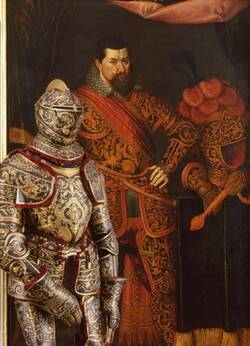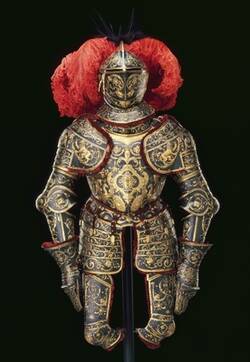Like the shining, gilded armours for knights and their chargers that Christian I once commissioned from Anton Peffenhauser, this ceremonial armour from Antwerp is also described in detail in the inventory of 1606. And like the Peffenhauser armours, this one was also displayed on a life-size, model horse in the Rüstkammer. According to the inventory, it comprised the following parts: “. . . the actual harness, a chanfron, two red plumes with yellow heron feathers, a velvet skirt with a gold border, black silk stockings, black velvet boots, gilded spurs and stirrups, a red velvet tournament saddle, riding accoutrements, a gilded bit, a hatchet, a rapier, and a belt with a gold border. The entire harness is decorated with slightly raised ornamentation on a black, tooled background.”
A portrait, from around 1620, in which we see the Elector of Saxony, Johann Georg I, wearing this armour also includes most of the items listed in the inventory. Take a look for yourself!
This picture by a court painter whose name is unknown to us shows Johann Georg I in the pose of a ruler: a huge man with a high forehead and an alert gaze. Although the perspective is a little shaky, the painter has meticulously reproduced the golden embossed motifs on the armour: flowers, foliage, fruit, lions, fabulous sphinxes and sirens, grotesques on the arms and thighs, and finally, the grim head of Medusa wreathed in serpents at the centre of the breastplate. Not in keeping with the inventory, however, the plumes on the helmet are red and black in the painting, the velvet skirt is missing altogether, and the artist has evidently also taken some licence with the boots. Instead of black velvet boots, we see iron boots, with the same pattern as on the rest of the harness.
Elector Christian II purchased the black-and-gold armour for his younger brother, Johann Georg, presumably as a present on the occasion of his marriage to Sibylla Elisabeth von Württemberg on 16 September 1604. With this purchase, Christian II demonstrated both his expertise and his exquisite taste. For this armour was, and still is, one of the finest examples of the armourer’s and goldsmith’s art in the whole of Europe.
As a matter of fact, this armour was not specially commissioned for Johann Georg’s wedding. It had been made for a different wedding – or, at least, to woo a bride. It was already about fifty years old when Heinrich Cnoep, a goldsmith and merchant whose personal connections extended to the Court of Denmark, offered it to Christian II, who will have been in no doubt that it was made in the workshop of the Antwerp goldsmith Eliseus Libaerts. However, it is by no means clear whose hands it had passed through in the intervening fifty years.
The respected goldsmith and merchant Eliseus Libaerts was on his way to one of his illustrious clients, King Erik XIV of Sweden, when he was forced at gunpoint to change his plans and travel instead to Copenhagen – together with all his wares, including our Dresden armour. The war raging between Sweden and Denmark at the time partly accounts for this lawlessness. It’s not known whether the Danish king ever returned the harness to Libaerts. But one thing is certain: the Libaerts Armour is one of the highlights of this exhibition and one of the most important items in our collection.


